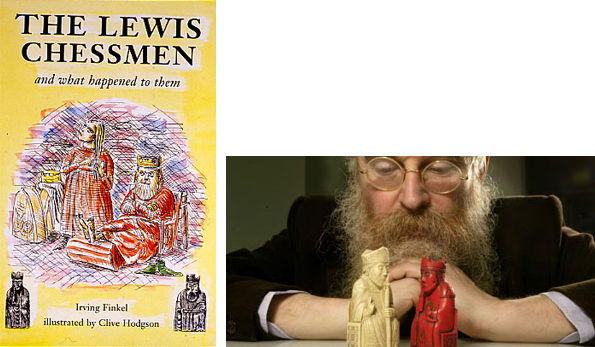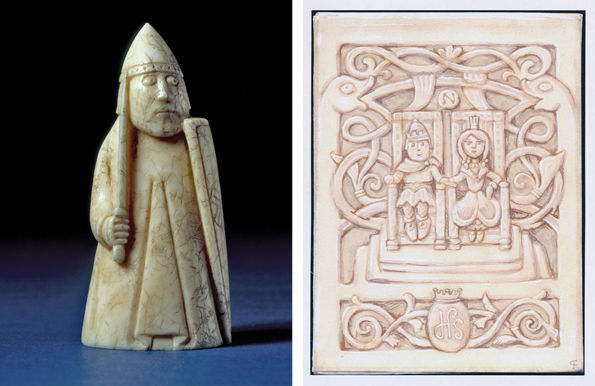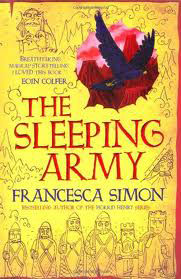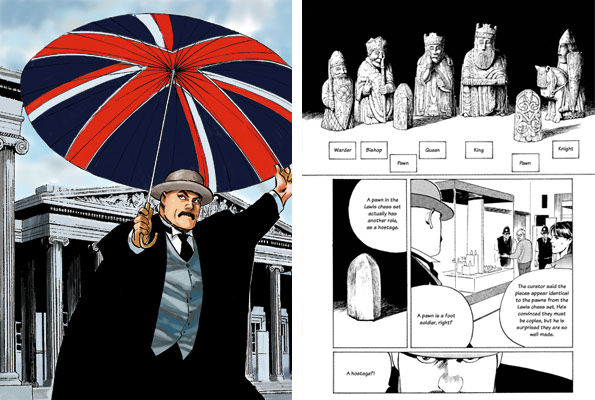From the very moment of their discovery in 1831, the Lewis Chessmen have captured the imagination of all who encounter them. Local legend relates how the peasant who first unearthed them from a sand dune in Uig Bay ran for his life, fearing that they were sprites or elves. The chessmen have certainly worked their magic over the years, acting not only as inspiration to writers of fiction but also to filmmakers and the occasional museum curator. Irving Finkel of the British Museum's Middle East department—a leading authority on cuneiform tablets—first visited the museum as a young boy and was introduced to the curator in charge of the Lewis Chessmen at that time, Michael Taylor. It was this meeting that set Irving on his career path. His love of the chessmen was given full expression in a children's book that he wrote in 1995, The Lewis Chessmen and What Happened to Them.
Cover of the children's book written by Irving Finkel, who is shown at right.
Irving's personal collection of vintage red and cream chessmen, seen above, were borrowed by the makers of the movie Harry Potter and the Sorcerer's Stone. The film uses the chessmen to dramatic effect in a game of Wizard's chess. In an animated sequence at a vital moment in the game, the glum queen steps out of her throne, seizes it, and smashes it over a knight. The enormous success of the Harry Potter series saw record numbers of young people taking up an interest in the game of chess. Harry Potter chess sets are still quite popular and, indeed, for many visitors to the British Museum, the Lewis Chessmen are now known as the "Harry Potter chessmen."
Left: Harry and Ron play Wizard's chess in the film Harry Potter and the Sorcerer's Stone; Right: a Harry Potter–themed chess set.
Long before Harry Potter was a twinkle in the author J. K. Rowling's eye, a pair of British animators had already succumbed to the mysterious charm of the Lewis Chessmen. Peter Firmin and Oliver Postgate were responsible for a number of seminal children's television programmes broadcast by the BBC from the 1950s to the 1990s. They, like Irving Finkel, visited the museum and were completely transfixed by the chessmen, instinctively naming one of them "Noggin."
Left: Warder, ca. 1150–1200. Scandinavian, probably Norway, found on the Isle of Lewis, Outer Hebrides, Scotland, 1831. Walrus ivory. The British Museum, London (1831,1101.123); Right: Original artwork by Peter Firmin showing Noggin with his queen against a design derived from one of the thrones of the Lewis pieces.
"Noggin"—the Warder shown above—is endowed with a truly distinctive character. The piece is modeled as a foot soldier, an infantryman, and takes the position of the rook in the modern game. Of all the Lewis Chessmen, this is the sole example that is not carved with an unambiguously frontal stance. The slight turn and sideways glance of the figure lends it a unique emotional quality that suggests uncertainty, hesitancy. Firmin and Postgate clearly appreciated this and were suitably inspired to build a fantasy around Noggin, King of the Nogs. The animations that resulted were broadcast for nearly forty years. The films were beautifully evocative of the Norse world and of the oral storytelling that was characteristic of that society.
This rich, mythological past that the chessmen inhabit led the children's writer Francesca Simon to place them at the center of her most recent book, The Sleeping Army.
Cover of The Sleeping Army, which features chess pieces inspired by the Lewis Chessmen.
The Sleeping Army is set in a world with all the trappings of modern society but with one significant difference—Christianity has never caught on, and the Norse gods are still worshipped, at least notionally. The heroine, Freya, finds herself transported from the medieval room at the British Museum to the realm of the gods in the company of three of the chess pieces—a Queen, a King, and a Berserker—who are magically brought to life.
The universal appeal and general understanding of the game of chess empowers the Lewis Chessmen to reach across cultures. They are, undoubtedly, the most well travelled of all the British Museum's treasures and have been shown in venues from Korea to Norway, from Australia to America. They never fail to mesmerize their audiences, despite their very diminutive proportions. Recently, they were instrumental, if not critical, in persuading the Japanese manga artist Hoshino Yukinobu to collaborate on a project with the British Museum that has resulted in two exhibitions and a publication. The current exhibition, Manga at the British Museum: Drawings by Hoshino Yukinobu, shows original artwork from the manga series Professor Munakata's British Museum Adventure.
Left: Poster image for the current exhibition Manga at the British Museum: Drawings by Hoshino Yukinobu; Right: Detail of a page from a book in the series Professor Munakata's British Museum Adventure by Hoshino Yukinobu.




